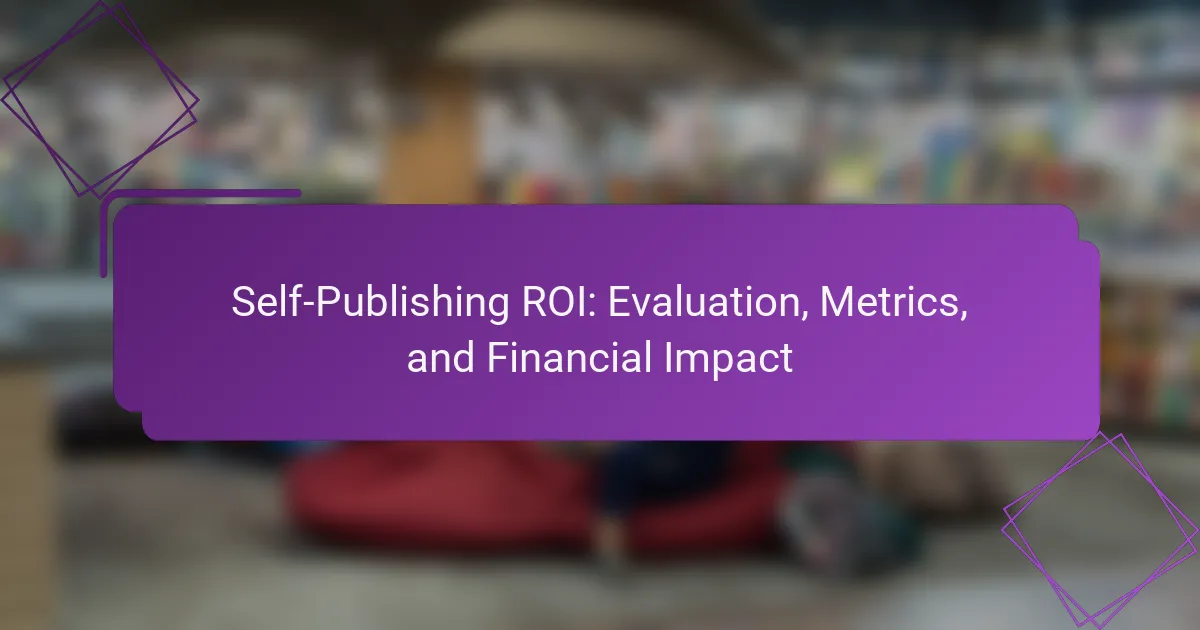Understanding the return on investment (ROI) in self-publishing is crucial for authors looking to evaluate the financial success of their projects. By analyzing costs against revenue, writers can gain insights into profitability and make informed decisions for future works. Key metrics such as sales figures and marketing conversion rates play a vital role in assessing performance and guiding strategic planning.
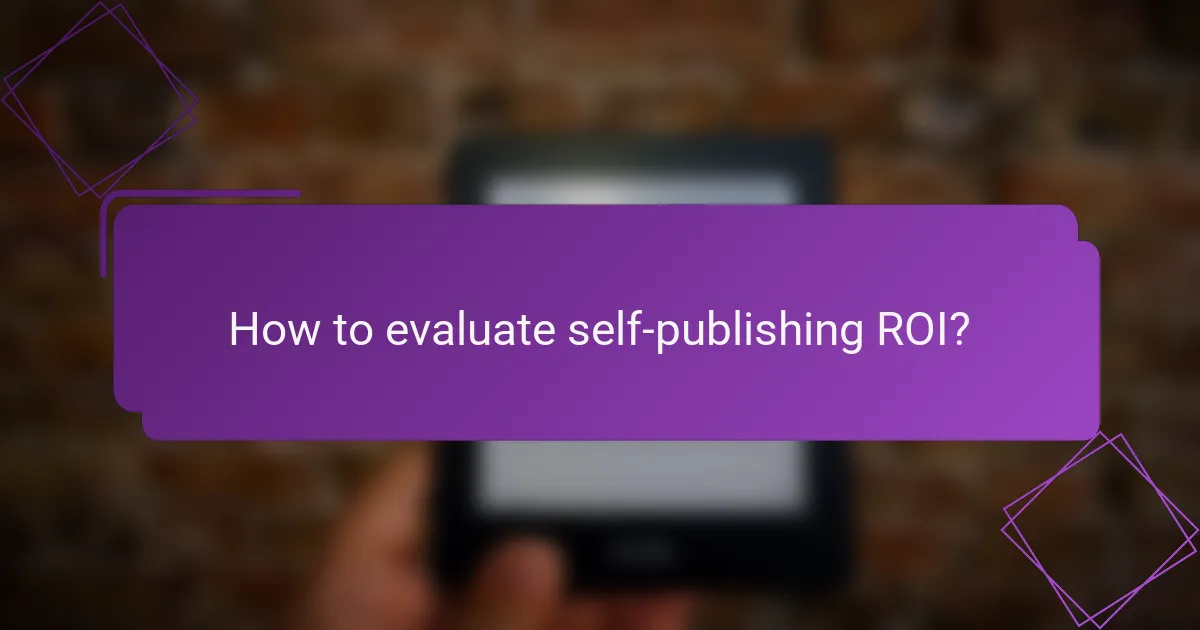
How to evaluate self-publishing ROI?
Evaluating self-publishing ROI involves analyzing the costs incurred against the revenue generated from book sales. This assessment helps authors understand the financial viability of their projects and make informed decisions for future publications.
Cost analysis of self-publishing
Cost analysis for self-publishing includes various expenses such as editing, cover design, formatting, and marketing. Authors should expect to spend anywhere from a few hundred to several thousand USD depending on the quality and services chosen.
It’s essential to create a detailed budget that outlines all potential costs. This budget should include both fixed costs, like ISBN purchases, and variable costs, such as promotional campaigns, which can fluctuate based on strategy and market response.
Revenue projections from book sales
Revenue projections should be based on realistic sales estimates, considering factors like genre popularity and target audience size. Many self-published authors aim for sales in the range of hundreds to thousands of copies in the first year.
To enhance revenue, authors can explore multiple sales channels, including e-books, print-on-demand, and audiobooks. Setting competitive pricing while offering promotions can also help boost initial sales and attract readers.
Break-even analysis for self-published authors
Break-even analysis determines how many copies an author needs to sell to cover their initial investment. This calculation is crucial for understanding the timeline for profitability.
To conduct a break-even analysis, divide total costs by the profit per book sold. For instance, if total costs are $2,000 and the profit per book is $5, the author would need to sell 400 copies to break even. Regularly revisiting this analysis can help authors adjust their strategies as needed.
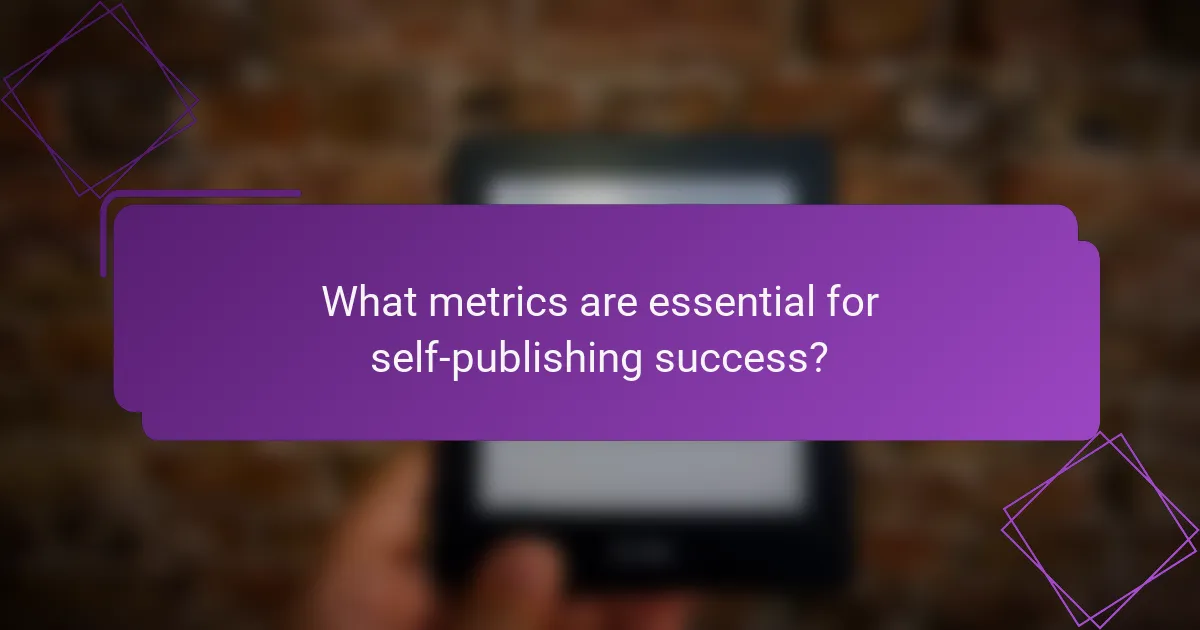
What metrics are essential for self-publishing success?
Essential metrics for self-publishing success include sales figures, reader engagement, and marketing conversion rates. These indicators help authors evaluate their book’s performance and inform future strategies.
Sales figures and trends
Sales figures reveal how many copies of your book are sold over a specific period. Tracking trends in sales can help identify peak times, such as holidays or promotional events, which can guide future marketing efforts.
Consider using platforms like Amazon KDP or IngramSpark, which provide sales data and trends. Aim to analyze your sales monthly to spot patterns and adjust your strategies accordingly.
Reader engagement metrics
Reader engagement metrics include reviews, ratings, and social media interactions. High engagement often correlates with increased sales, as engaged readers are more likely to recommend your book.
Monitor platforms like Goodreads and social media for feedback. Aim for a balance of positive reviews and constructive criticism, as both can enhance your book’s visibility and credibility.
Marketing conversion rates
Marketing conversion rates measure how effectively your promotional efforts turn potential readers into buyers. This metric is crucial for assessing the return on investment (ROI) of your marketing campaigns.
Calculate conversion rates by dividing the number of sales by the number of visitors to your sales page. A typical conversion rate for book sales ranges from 1% to 5%. Focus on optimizing your marketing channels to improve these rates, such as refining your email campaigns or social media ads.
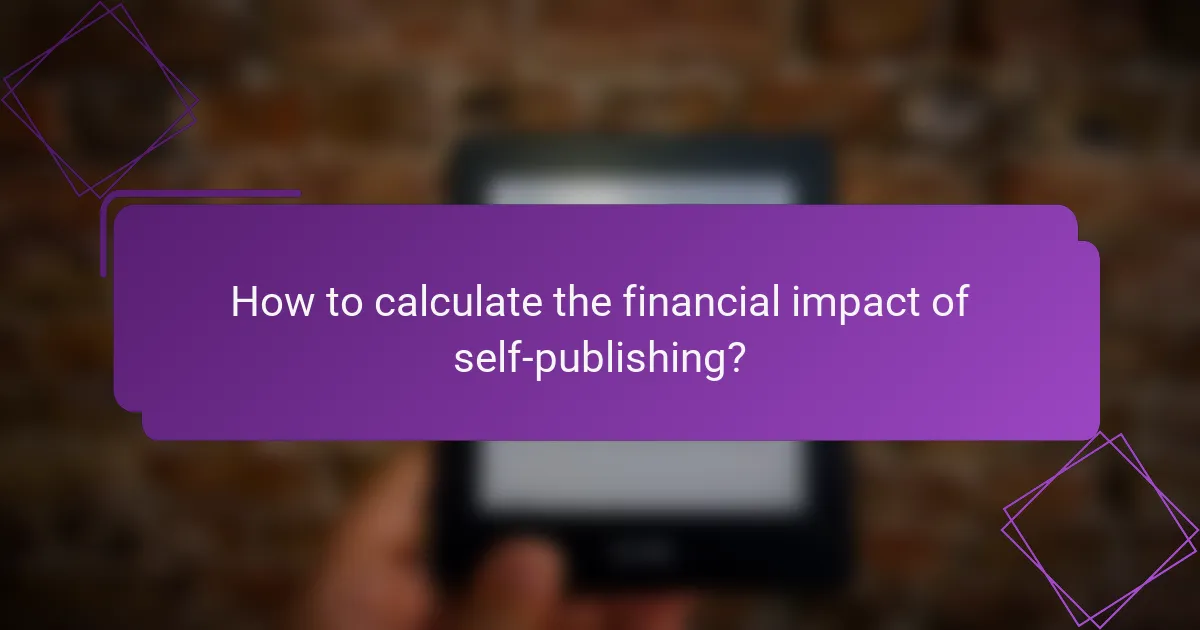
How to calculate the financial impact of self-publishing?
To calculate the financial impact of self-publishing, authors should assess their total revenue against expenses to determine profitability. Key metrics include profit margins, long-term income potential, and the influence of distribution channels.
Profit margin calculations
Profit margin calculations involve subtracting total expenses from total revenue to find the net profit, then dividing that figure by total revenue. This percentage indicates how much profit is made for every dollar earned. For example, if an author earns $10,000 and incurs $4,000 in expenses, the profit margin would be 60%.
Authors should consider both direct costs, like editing and cover design, and indirect costs, such as marketing and distribution fees. Keeping expenses in check while maximizing revenue through various pricing strategies can significantly enhance profit margins.
Long-term income potential
Long-term income potential from self-publishing can vary widely based on factors such as genre, marketing efforts, and audience engagement. Many authors find that their books continue to generate income over time, especially if they build a loyal readership and expand their catalog.
To maximize long-term earnings, authors should focus on creating a series or related works, as this can encourage repeat purchases. Additionally, leveraging platforms like Amazon Kindle Direct Publishing can help maintain visibility and sales over the years.
Impact of distribution channels
The choice of distribution channels significantly affects the financial impact of self-publishing. Authors can opt for exclusive agreements with platforms like Amazon, which may offer higher royalties, or choose wider distribution through services like IngramSpark, which can reach bookstores and libraries.
Understanding the trade-offs between these channels is crucial. Exclusive channels may provide higher upfront earnings but limit exposure, while wider distribution can increase sales volume but often comes with lower royalty rates. Authors should evaluate their goals and target audience to select the most effective distribution strategy.

What are the best practices for maximizing ROI in self-publishing?
To maximize ROI in self-publishing, focus on effective marketing, building a strong author brand, and leveraging social media. These strategies can significantly enhance visibility and sales, ultimately improving your financial returns.
Effective marketing strategies
Implementing effective marketing strategies is crucial for boosting your self-publishing ROI. Consider using email marketing campaigns to reach potential readers directly, as this can yield high engagement rates. Additionally, investing in targeted online ads can help you reach specific demographics likely to be interested in your book.
Utilize promotional tactics such as limited-time discounts or giveaways to generate buzz and attract new readers. Collaborating with book bloggers or influencers can also expand your reach and credibility, leading to increased sales.
Leveraging social media platforms
Social media platforms are powerful tools for self-publishers looking to maximize ROI. Create accounts on popular platforms like Facebook, Instagram, and Twitter to engage with your audience and promote your work. Regularly sharing content related to your books, such as excerpts, cover reveals, or behind-the-scenes insights, can keep your followers interested.
Consider using paid advertising options on these platforms to target specific audiences based on their interests and behaviors. This can lead to higher conversion rates and a better return on your marketing investment.
Building an author brand
Building a strong author brand is essential for long-term success in self-publishing. Your brand should reflect your unique voice and style, making it easier for readers to connect with you. Consistency in your messaging, visuals, and engagement across all platforms helps establish trust and recognition.
Engage with your readers through newsletters, social media interactions, and author events. This not only fosters loyalty but also encourages word-of-mouth marketing, which can significantly enhance your ROI over time.

What tools can help track self-publishing metrics?
To effectively track self-publishing metrics, authors can utilize various tools that provide insights into sales performance, website traffic, and reader engagement. These tools help in evaluating the financial impact of self-publishing efforts and inform future marketing strategies.
Amazon KDP reports
Amazon KDP offers detailed reports that allow authors to track their book sales, royalties, and performance metrics. These reports can be accessed through the KDP dashboard and typically include data on units sold, earnings, and trends over time.
Authors can analyze this data to identify which titles are performing well and which may need additional marketing efforts. Regularly reviewing these reports can help authors adjust their strategies to maximize revenue.
Google Analytics for author websites
Google Analytics is a powerful tool for tracking visitor behavior on an author’s website. By setting up Google Analytics, authors can monitor traffic sources, page views, and user engagement metrics, which are crucial for understanding how readers interact with their content.
Using this data, authors can optimize their websites to improve user experience and increase conversions, such as newsletter sign-ups or book purchases. It’s important to regularly review these metrics to refine marketing strategies and enhance online presence.
Book tracking software like Book Tracker
Book tracking software, such as Book Tracker, helps authors manage their book inventory and sales data across multiple platforms. These tools can consolidate sales information from various retailers, providing a comprehensive view of overall performance.
When choosing book tracking software, consider features like sales forecasting, royalty calculations, and reporting capabilities. This software can save time and reduce errors in tracking sales, allowing authors to focus more on writing and marketing their books.
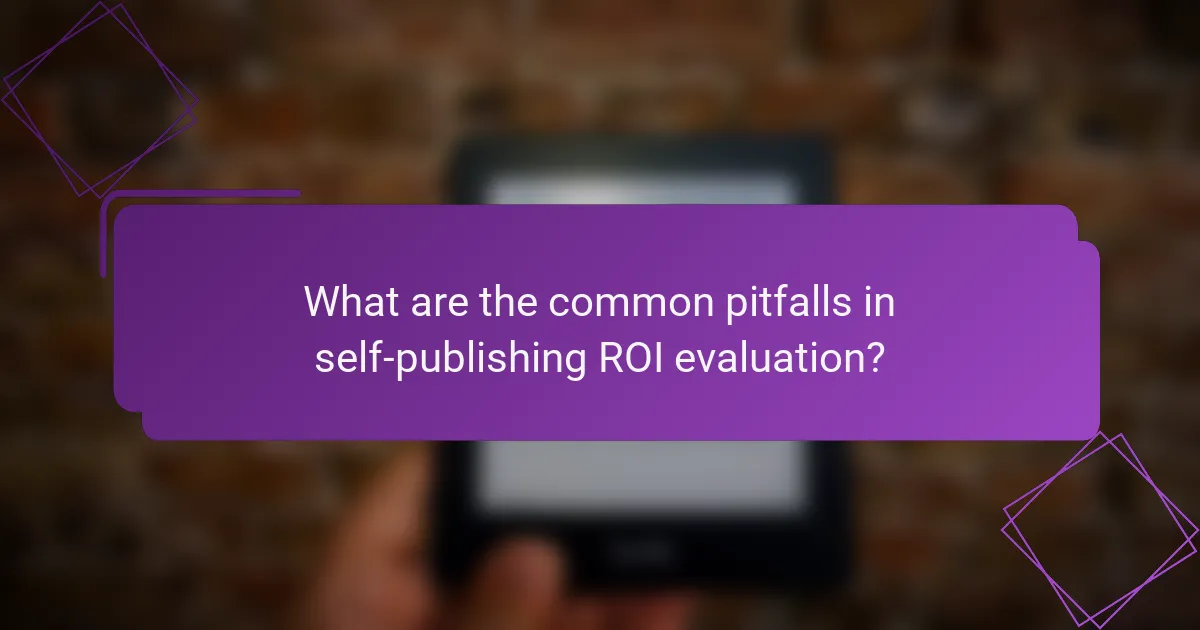
What are the common pitfalls in self-publishing ROI evaluation?
Common pitfalls in self-publishing ROI evaluation include overestimating sales potential and neglecting hidden costs. Recognizing these issues can help authors make more informed financial decisions and improve their overall profitability.
Overestimating sales potential
Many self-published authors fall into the trap of overestimating their sales potential. This often stems from inflated expectations based on anecdotal success stories or viral trends. Realistic projections should consider factors like genre demand, target audience size, and marketing effectiveness.
To avoid this pitfall, conduct thorough market research. Analyze similar titles in your genre, their sales figures, and reader reviews. Setting conservative sales goals can provide a more accurate picture of potential earnings, allowing for better financial planning.
Neglecting hidden costs
Hidden costs can significantly impact the ROI of self-publishing. Authors often overlook expenses such as editing, cover design, formatting, and marketing. These costs can add up quickly and should be factored into any financial evaluation.
To manage these expenses, create a detailed budget that includes all potential costs. Consider using a checklist to ensure you account for each item, such as professional services and promotional activities. Understanding these hidden costs will provide a clearer view of your actual profit margins and help you make smarter investment decisions.
